
在 tf_agents 中,timestepspec 和 timestep 是定义环境交互数据的核心结构。
理解 spec.shape(单个元素形状)与 tensor.shape(批处理张量形状)之间的区别至关重要。如果 spec.shape 是 S,且批处理大小为 B,那么对应的实际张量形状应该是 (B,) + S。
InvalidArgumentError: 'then' and 'else' must have the same size. but received: [1] vs. [] 这个错误通常发生在策略内部,特别是 epsilon_greedy_policy 等探索性策略中,它们会使用 tf.where 等条件语句来选择贪婪动作或随机动作。当 tf.where(condition, x, y) 被调用时,x 和 y 必须能够广播到 condition 的形状。如果 x 和 y 的形状不一致,就会触发此错误。
导致此问题的常见误区在于对 TimeStepSpec 中标量组件的形状定义。考虑以下原始的 TimeStepSpec 定义片段:
time_step_spec = TimeStep(
step_type = tensor_spec.BoundedTensorSpec(shape=(1,), dtype=tf.int32, minimum=0, maximum=2),
reward = tensor_spec.TensorSpec(shape=(1,), dtype=tf.float32),
discount = tensor_spec.TensorSpec(shape=(1,), dtype=tf.float32),
observation = tensor_spec.TensorSpec(shape=(1,amountMachines), dtype=tf.int32)
)以及对应的 TimeStep 数据创建片段(假设 batch_size = 1):
time_step = TimeStep(
step_type=tf.convert_to_tensor([step_type_value], dtype=tf.int32), # 结果形状 (1,)
reward=tf.convert_to_tensor([reward_value], dtype=tf.float32), # 结果形状 (1,)
discount=tf.convert_to_tensor([discount_value], dtype=tf.float32), # 结果形状 (1,)
observation=current_state_batch # 结果形状 (1, amountMachines)
)乍一看,time_step_spec 中 shape=(1,) 与 time_step 中 tf.convert_to_tensor([value]) 产生的 (1,) 形状似乎是匹配的。然而,这里的关键在于 tf_agents 对 TimeStepSpec 中 shape 的解释:
因此,当 TimeStepSpec 中将标量定义为 shape=(1,) 时,tf_agents 内部会期望每个批处理元素都是一个形状为 (1,) 的张量。但实际传入的 tf.convert_to_tensor([value]) 产生的 (1,) 形状,在某些内部操作(如 tf.where)中,可能会与预期产生混淆,导致一个分支得到 (1,) 而另一个得到 () 的动作张量,从而引发 InvalidArgumentError。
解决此问题的关键是确保 TimeStepSpec 正确反映每个组件在单个时间步内的实际维度。对于像 step_type、reward 和 discount 这样的标量值,它们的 shape 应该定义为 ()。
正确的 TimeStepSpec 定义:
import tensorflow as tf
from tf_agents.trajectories import time_step as ts
from tf_agents.specs import tensor_spec
from tf_agents.agents.dqn import dqn_agent
from tf_agents.utils import common
# 假设 amountMachines 已定义,例如 amountMachines = 6
amountMachines = 6
learning_rate = 1e-3
train_step_counter = tf.Variable(0) # 示例
# 修正后的 time_step_spec
time_step_spec = ts.TimeStep(
step_type = tensor_spec.BoundedTensorSpec(shape=(), dtype=tf.int32, minimum=0, maximum=2), # 修正:shape=()
reward = tensor_spec.TensorSpec(shape=(), dtype=tf.float32), # 修正:shape=()
discount = tensor_spec.TensorSpec(shape=(), dtype=tf.float32), # 修正:shape=()
observation = tensor_spec.TensorSpec(shape=(amountMachines,), dtype=tf.int32) # 修正:shape=(amountMachines,)
)
num_possible_actions = 729
action_spec = tensor_spec.BoundedTensorSpec(
shape=(), dtype=tf.int32, minimum=0, maximum=num_possible_actions - 1)
# 假设以上就是TensorFlow Agents DQN InvalidArgumentError: 解决 collect_policy 中的形状不匹配问题的详细内容,更多请关注php中文网其它相关文章!

每个人都需要一台速度更快、更稳定的 PC。随着时间的推移,垃圾文件、旧注册表数据和不必要的后台进程会占用资源并降低性能。幸运的是,许多工具可以让 Windows 保持平稳运行。

Copyright 2014-2025 https://www.php.cn/ All Rights Reserved | php.cn | 湘ICP备2023035733号